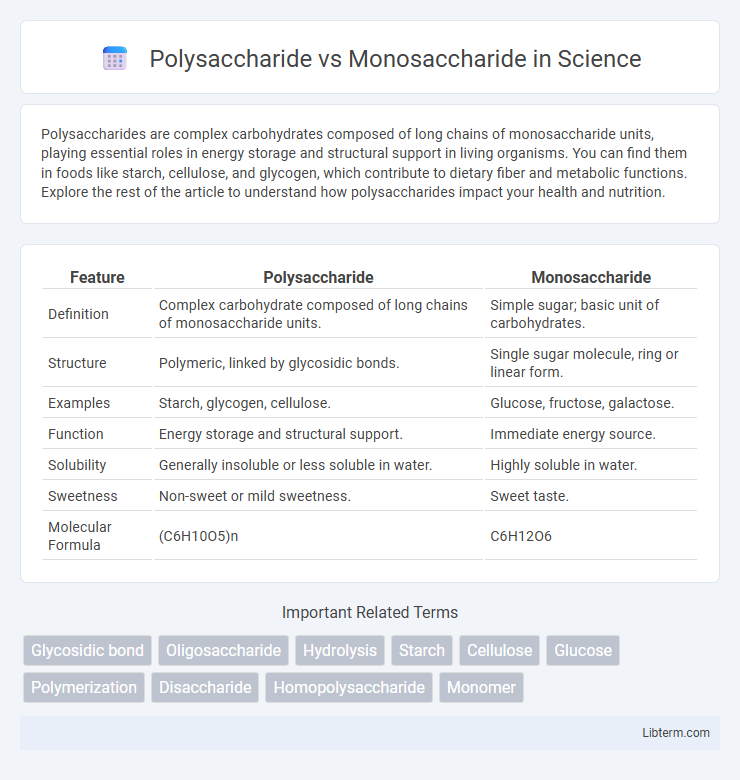Polysaccharides are complex carbohydrates composed of long chains of monosaccharide units, playing essential roles in energy storage and structural support in living organisms. You can find them in foods like starch, cellulose, and glycogen, which contribute to dietary fiber and metabolic functions. Explore the rest of the article to understand how polysaccharides impact your health and nutrition.
Table of Comparison
| Feature | Polysaccharide | Monosaccharide |
|---|---|---|
| Definition | Complex carbohydrate composed of long chains of monosaccharide units. | Simple sugar; basic unit of carbohydrates. |
| Structure | Polymeric, linked by glycosidic bonds. | Single sugar molecule, ring or linear form. |
| Examples | Starch, glycogen, cellulose. | Glucose, fructose, galactose. |
| Function | Energy storage and structural support. | Immediate energy source. |
| Solubility | Generally insoluble or less soluble in water. | Highly soluble in water. |
| Sweetness | Non-sweet or mild sweetness. | Sweet taste. |
| Molecular Formula | (C6H10O5)n | C6H12O6 |
Introduction to Saccharides
Saccharides are carbohydrates comprising simple sugars like monosaccharides and complex forms such as polysaccharides, essential for energy storage and structural functions in living organisms. Monosaccharides like glucose and fructose are single sugar units that serve as fundamental building blocks for polysaccharides. Polysaccharides, including starch, cellulose, and glycogen, consist of long chains of monosaccharide units linked by glycosidic bonds and play critical roles in biological processes and nutrition.
Defining Monosaccharides
Monosaccharides are the simplest form of carbohydrates consisting of single sugar units with the general formula (CH2O)n, where n typically ranges from 3 to 7. These molecules, such as glucose, fructose, and galactose, serve as fundamental energy sources and building blocks for more complex polysaccharides like starch, cellulose, and glycogen. Monosaccharides are characterized by their ability to exist in linear or ring structures and their high solubility in water, facilitating cellular metabolism and biochemical reactions.
Structure and Properties of Monosaccharides
Monosaccharides are the simplest form of carbohydrates, consisting of a single sugar unit with a general formula (CH2O)n, where n typically ranges from 3 to 7. They exhibit properties such as high solubility in water, sweetness, and the ability to act as reducing sugars due to their free aldehyde or ketone groups. In contrast, polysaccharides are complex carbohydrates made up of long chains of monosaccharide units linked by glycosidic bonds, resulting in macromolecules that are typically insoluble and serve as energy storage or structural components.
Overview of Polysaccharides
Polysaccharides are complex carbohydrates composed of long chains of monosaccharide units linked by glycosidic bonds, serving as energy storage and structural components in organisms. Common examples include starch, glycogen, and cellulose, each playing vital roles in plants and animals. Their high molecular weight and branched or unbranched structures influence digestibility and functional properties in biological systems.
Structural Differences: Monosaccharide vs. Polysaccharide
Monosaccharides are the simplest carbohydrates consisting of a single sugar molecule with a basic structure of carbon, hydrogen, and oxygen atoms in a 1:2:1 ratio, often forming ring or linear shapes. Polysaccharides are complex carbohydrates composed of long chains of monosaccharide units linked by glycosidic bonds, creating large macromolecules such as starch, cellulose, and glycogen. The primary structural difference lies in monosaccharides being single units that serve as building blocks, while polysaccharides are polymers that provide energy storage or structural support in plants and animals.
Biological Roles of Monosaccharides
Monosaccharides serve as fundamental energy sources and metabolic intermediates in cellular respiration, providing essential fuel for ATP production. They act as building blocks for more complex carbohydrates such as polysaccharides, glycoproteins, and glycolipids, crucial for structural support and cell recognition. Key examples include glucose, which drives cellular energy metabolism, and ribose, which forms the backbone of RNA and other nucleotides involved in genetic information processing.
Functions of Polysaccharides in Living Organisms
Polysaccharides serve vital functions in living organisms by providing long-term energy storage, structural support, and cellular recognition. Common examples include starch and glycogen for energy reserves in plants and animals, respectively, while cellulose offers rigidity and protection in plant cell walls. These complex carbohydrates also play roles in cell signaling and immune responses through glycoprotein formation.
Dietary Sources and Health Impact
Polysaccharides, found in foods like whole grains, legumes, and vegetables, provide sustained energy and promote digestive health through their high fiber content, which aids in blood sugar regulation and gut microbiota balance. Monosaccharides, such as glucose and fructose present in fruits, honey, and processed sugars, are rapidly absorbed and can cause quick spikes in blood sugar levels, potentially leading to insulin resistance if consumed excessively. Choosing polysaccharide-rich foods supports long-term metabolic health and reduces the risk of chronic diseases compared to diets high in simple monosaccharides.
Applications in Food and Industry
Polysaccharides such as starch and cellulose are widely used as thickeners, stabilizers, and dietary fibers in food products, enhancing texture and nutritional value, while their biodegradable properties make them essential in bio-packaging and pharmaceuticals. Monosaccharides like glucose and fructose serve as key sweeteners and fermentation substrates in the food industry, facilitating energy production in biofuels and alcoholic beverages. Industrial applications leverage monosaccharides for biochemical syntheses, whereas polysaccharides provide renewable raw materials for bioplastics and emulsifiers.
Key Differences: Polysaccharide vs Monosaccharide Summary
Polysaccharides are complex carbohydrates composed of long chains of monosaccharide units linked by glycosidic bonds, serving primarily as energy storage (e.g., starch, glycogen) and structural components (e.g., cellulose) in plants and animals. Monosaccharides, such as glucose and fructose, are simple sugars that act as the basic building blocks for polysaccharides and provide immediate energy. The key difference lies in their structure complexity, with monosaccharides being single sugar molecules and polysaccharides being large, complex molecules made up of many monosaccharide units.
Polysaccharide Infographic

 libterm.com
libterm.com